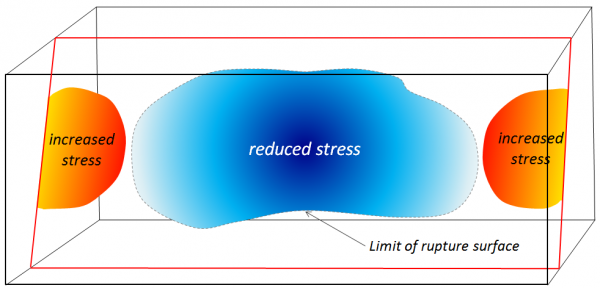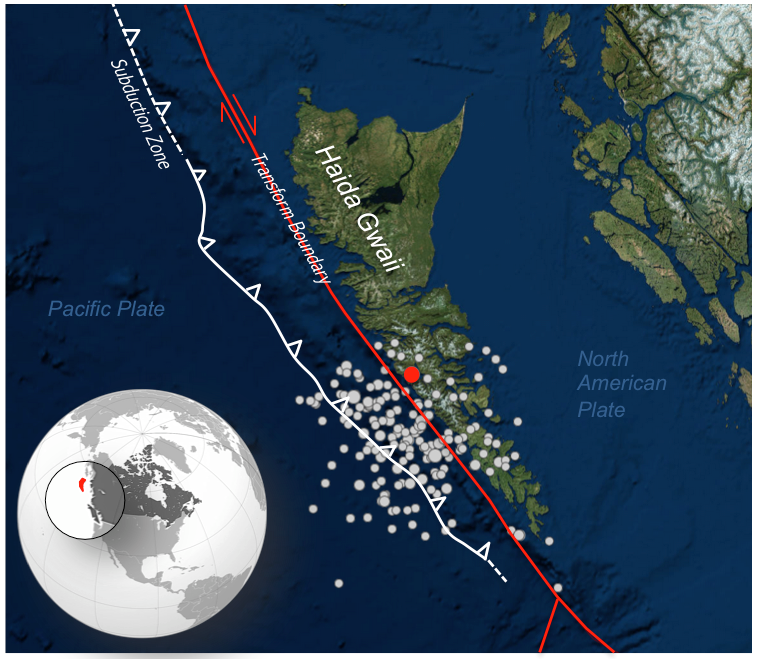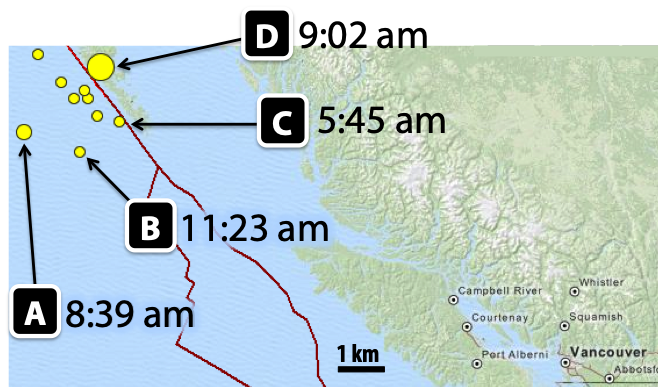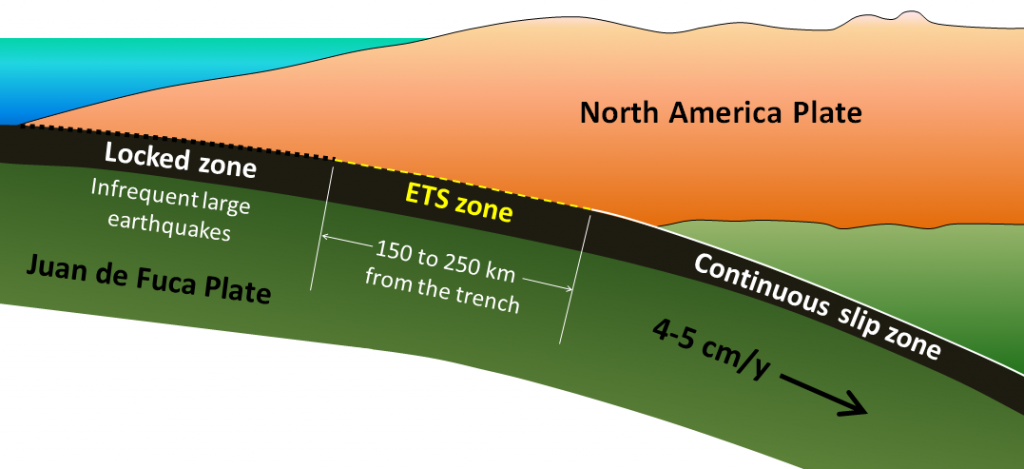12.1 What is an Earthquake?
Earthquake Shaking Comes from Elastic Deformation
Earthquakes occur when rock ruptures (breaks), causing rocks on one side of a fault to move relative to the rocks on the other side. Although motion along a fault is part of what happens when an earthquake occurs, rocks grinding past each other isn’t what creates the shaking. In fact, it could be said that the earthquake happens after rocks have undergone most of the displacement. Consider this: if rocks slide a few centimetres or even metres along a fault, would that motion alone explain the incredible damage caused by some earthquakes? If you were in a car that suddenly accelerated then stopped, you’d feel a jolt. But earthquakes aren’t a single jolt. Buildings can swing back and forth until they shake themselves to pieces, train tracks can buckle and twist into s-shapes, and roads can roll up and down like waves on the ocean. During an earthquake, rock is not only slipping—it’s also vibrating like a plucked guitar string.
Rocks might seem rigid, but when stress is applied, they may stretch. If there hasn’t been too much stretching, a rock will snap back to its original shape once the stress is removed. Deformation that is reversible is called elastic deformation.
Rocks that are stressed beyond their ability to stretch can rupture, allowing the rest of the rock to snap back to its original shape. The snapping back—called elastic rebound—causes the rock to vibrate, and this is what causes the shaking during an earthquake.
Figure 12.3 (top) shows this sequence of events. Stress is applied to a rock and deforms it. The deformed rock ruptures, forming a fault. After rupturing, the rock above and below the fault snaps back to the shape it had before deformation.

Ruptures can also occur along pre-existing faults (Figure 12.3, bottom). The rocks on either side of the fault are locked together because bumps along the fault, called asperities, prevent the rocks from moving relative to each other. When the stress is great enough to break the asperities, the rocks on either side of the fault can slide again. While the rocks are locked together, stress can cause elastic deformation. When asperities break and release the stress, the rocks undergo elastic rebound and return to their original shape.
Rupture Surfaces Are Where the Action Happens
Images like 12.3 are useful for illustrating elastic deformation and rupture, but they can be misleading. The rupture that happens doesn’t necessarily break the rock through and through. Rupture and displacement only happen along a subsection of a fault, called the rupture surface, although the rupture surface could extend 10s to 100s of kilometres. In Figure 12.4, the rupture surface is the dark pink patch. It takes up only a part of the fault plane (lighter pink). The fault plane represents the surface where the fault exists, and where ruptures have happened in the past. Although the fault plane is drawn as being flat in Figure 12.4, faults are not actually perfectly flat.
The location on the fault plane where the rupture happens is called the hypocentre or focus of the earthquake (Figure 12.4, right). The location on Earth’s surface immediately above the hypocentre is the epicentre of the earthquake.

Within the rupture surface, the amount of displacement varies. In Figure 12.4, the larger arrows indicate where there has been more displacement, and the smaller arrows where there has been less. Beyond the edge of the rupture surface there is no displacement at all. Notice that this particular rupture surface doesn’t extend to the land surface of the diagram.
The size of a rupture surface and the amount of displacement along it will depend on a number of factors, including the type and strength of the rock, and the degree to which the rock was stressed beforehand. The magnitude of an earthquake will depend on the size of the rupture surface and the amount of displacement.
A rupture doesn’t occur all at once along a rupture surface. It starts at a single point and spreads rapidly from there. Figure 12.4 illustrates a case where rupturing starts at the heavy blue arrow in the middle, then continues through the lighter blue arrows. The rupture spreads to the left side (green arrows), then the right (yellow arrows).
Depending on the extent of the rupture surface, the propagation of failures (incremental ruptures contributing to making the final rupture surface) from the point of initiation is typically completed within seconds to several tens of seconds. The initiation point isn’t necessarily in the centre of the rupture surface; it may be close to one end, near the top, or near the bottom.
Concept Check: What Is an Earthquake?
Write the words into the correct blank.
When rocks are stretched, then snap back to their original shape in a process called . They vibrate like a plucked guitar string, and this is what we feel as an .
Rocks break on a surface that takes up only part of the plane. (Earthquakes can happen in many locations on this plane over time.)
The location where slip happens on the fault plane within the Earth is the . The is the location on the surface above actual slip.
Fill-in-the-blank options:
- elastic rebound
- fault
- earthquake
- epicentre
- rupture
- hypocentre or focus
To check your answers, navigate to the below link to view the interactive version of this activity.
Shifting Stress Causes Foreshocks and Aftershocks
Earthquakes don’t usually occur in isolation. There’s often a sequence of smaller earthquakes before a larger one, and then progressively smaller earthquakes after. The largest earthquake in the series is the mainshock. The smaller ones that come before are foreshocks, and the smaller ones that come after are aftershocks. These descriptions are relative: for example, the strongest earthquake in a series is classified as the mainshock, but if another even bigger one comes after it, the bigger one is called the mainshock, and the earlier one is reclassified as an foreshock.
Aftershocks and foreshocks are a larger-scale version of what happens when the failure on a rupture surface propagates from one part of that surface to another. The rupture illustrated in Figure 12.4 reduced stress in one area, but in doing so, transferred stress to others (Figure 12.5). Imagine your favourite action hero suspended from a frayed rope that’s breaking strand by strand. When a strand breaks, the tension on that strand is released, but the remaining strands must still hold up the hero. If another strand breaks under the increased burden, the remaining strands have an even greater burden than before. (Ideally the hero will escape before the entire rope gives out…you can imagine that now, so our story has a pleasant outcome.) In the same way that stress causes one strand after another to fail, a rupture can trigger subsequent ruptures nearby.

Numerous aftershocks were associated with the magnitude 7.8 earthquake that struck Haida Gwaii in October of 2012 (Figure 12.6; mainshock in red, aftershocks in grey). Some of the stress released by the mainshock was transferred to other nearby parts of the fault, and contributed to a cascade of smaller ruptures, including along other nearby faults. Notice how the aftershocks from the Haida Gwaii earthquake are scattered rather than located only on the main faults shown in the image.

The effects of stress transfer may not show immediately. Aftershocks can be delayed for hours, days, weeks, or even years. Because stress transfer affects a region, not just a single fault, and because there can be delays between the event that transferred stress and the one that was triggered by the transfer, it can sometimes be hard to be know whether one earthquake is actually associated with another, and whether a foreshock or aftershock should be assigned to a particular mainshock.
Concept Check: Foreshocks, Mainshocks, & Aftershocks

Fill in the correct letters to indicate which earthquake is a foreshock, mainshock, and aftershock.
Earthakes and are foreshocks.
Earthquake is the mainshock.
Earthquake is an aftershock.
To check your answers, navigate to the below link to view the interactive version of this activity.
Episodic Tremor and Slip
Episodic tremor and slip (ETS) is periodic slow sliding along part of a subduction boundary. It doesn’t produce recognizable earthquakes, but does produce seismic tremor (observed as rapid seismic vibrations on instruments). It was first discovered on the Vancouver Island part of the Cascadia subduction zone by Geological Survey of Canada geologists Herb Dragert and Gary Rogers.[1]
The boundary between the subducting Juan de Fuca plate and the North America plate can be divided into three segments (Figure 12.7). The cold upper part of the boundary is the locked zone. There the plates are stuck together for long periods of time. When slip does occur, it generates very large earthquakes. The last time the locked zone along Canada’s west coast slipped was January 26, 1700. It caused an earthquake of magnitude 9.

The warm lower part of the boundary, called the continuous slip zone, is sliding continuously because the warm rock is weaker. The central part of the boundary, the ETS zone, isn’t cold enough to be stuck, but isn’t warm enough to slide continuously. Instead it slips episodically approximately every 14 months for about 2 weeks, moving a few centimetres each time.
It might seem that periodic slip along this part of the plate helps to reduce tension, and thus reduce the risk of a large earthquake. In fact, the opposite is likely the case. The movement along the ETS part of the plate boundary transfers stress to the adjacent locked part of the plate. During the two-week ETS period, the transfer of stress means an increased chance of a large earthquake.
Since 2003, ETS processes have also been observed in subduction zones in Mexico and Japan.
Additional Resources
IRIS Teachable Moment slides for the October 2012 Haida Gwaii earthquake
References
Wang, K., Jiangheng, H., Schulzeck, F., Hyndman, R. D., and Riedel, M. (2015). Thermal condition of the 27 October 2012 Mw 7.8 Haida Gwaii subduction earthquake at the obliquely convergent Queen Charlotte Margin. Bulletin of the Seismological Society of America, 105(2B), 1290–1300. doi: 10.1785/0120140183
- Rogers, G. and Dragert, H. (2003). Episodic tremor and slip on the Cascadia subduction zone: The chatter of silent slip. Science, 300, 1942-1943. ↵

